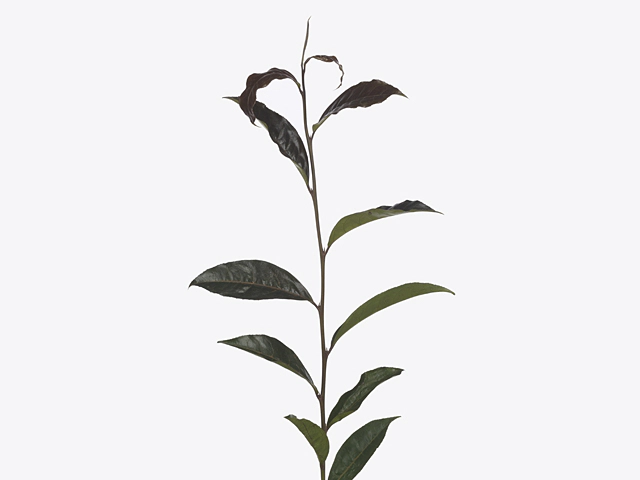Camellia sinensis var. assamica

| Leaf arrangement | spreaded |
| Leaf tip | Pointed/acute |
| Leaf margin | Erose |
| Leaf, general shape | Lanceolate |
| Leaf, scent | Unscented |
| Leaf width | 4 - 5 cm |
| Leaf surface | Glossy; Bullate |
| Leaf size | 10 - 15 cm |
| Leaf division | Simple |
| Leaf, main color | Brown-dark brown-200A; Green-dark brown green-NN137A |
| Leaf colour, pattern | Multi-colored |
Camellia sinensis var. assamica, also known as the Camellia tea plant, is a fascinating species that belongs to the genus Camellia. It is widely cultivated for its leaves, which are used to produce various types of tea. In this article, we will explore the characteristics of this remarkable plant.
One notable feature of Camellia sinensis var. assamica is its leaf arrangement, which is spreaded. The leaves are lanceolate in shape, with pointed or acute tips. The leaf margin is erose, giving the edges a slightly jagged appearance. These leaves have a glossy surface and are bullate, which means they have a blister-like texture. The average leaf size ranges from 10 to 15 cm, with a width of about 4 to 5 cm.
When it comes to color, Camellia sinensis var. assamica leaves display a range of shades. The main color can be described as brown-dark brown (200A) or green-dark brown green (NN137A). This multi-colored pattern adds visual interest to the plant and makes it an attractive addition to any garden or tea plantation.
What makes Camellia sinensis var. assamica particularly interesting is its unscented leaves. Unlike some other species of Camellia, this variety does not produce a distinctive fragrance. However, the lack of scent does not diminish its value as a tea plant. In fact, the leaves of Camellia sinensis var. assamica are highly prized for their rich flavor and medicinal properties.
It is important to note that while Camellia sinensis var. assamica is commonly used in tea production, there are other varieties of Camellia sinensis as well. Each variety has its own unique characteristics and flavors, making Camellia sinensis a diverse and versatile species.
In conclusion, Camellia sinensis var. assamica, known as the Camellia tea plant, is a remarkable species with attractive lanceolate leaves that are spreaded in arrangement. With an erose leaf margin and a glossy, bullate surface, these leaves exhibit stunning multi-colored patterns. Although they are unscented, the leaves of Camellia sinensis var. assamica are highly valued for their flavorful and medicinal qualities. Whether it's for a tea plantation or a garden, the Camellia tea plant is undoubtedly a captivating addition.
Market availability index by month:
| Jan. | Feb. | Mar. | Apr. | May | Jun. | Jul. | Aug. | Sep. | Oct. | Nov. | Dec. |
|---|---|---|---|---|---|---|---|---|---|---|---|
| 3 | 3 | 3 | 3 | 4 | 3 | 3 | 3 | 3 | 4 | 4 | 4 |